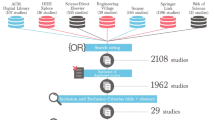Abstract
Nowadays, the term “student” embraces people with different needs and lifestyles (e.g., people with part-time or full-time jobs, people with some forms of disabilities, etc.) and, in the attempt to reach out to these students, many educational institutes are recording and releasing classroom lessons. In this paper, we share our experience building ONELab, a system designed to capture, record, edit and stream video lectures. ONELab was designed to provide flexibility to educational contents (i.e., no time and geographical constraints) and to improve the students’ learning process. Moreover, the system had to be scalable and cost-effective. The system has been used in the 2017-18 Academic Year to manage the 49 courses offered by the five-degree programs available at our Department. In numbers, it supported 1,251 students and produced 1,376 video lectures (for a total of 2,064 hours). The usage analysis showed that students want to adapt the learning process to their lifestyle and showed that students who used ONELab acquired more credits (+119%) and had better grades (+9.4%) than those who did not use the system.




Similar content being viewed by others
Notes
FFMPEG: available at www.ffmpeg.org.
References
Shah D (2018) By the numbers: Moocs in 2017. Class Central
Liu T, Kender JR (2004) Lecture videos for e-learning: current research and challenges. In: Proceedings of the IEEE international symposium on multimedia software engineering, pp 574–578
Zhang D, Zhou L, Briggs RO, Nunamaker JF Jr (2006) Instructional video in e-learning assessing the impact of interactive video on learning effectiveness. Inf Manag 43(1):15–27
Calandra B, Brantley-Dias L, Dias M (2006) Using digital video for professional development in urban schools. J Comput Teach Educ 22(4):137–145
Federico M, Furini M (2014) An automatic caption alignment mechanism for off-the-shelf speech recognition technologies. Multimed Tools Appl 72(1):21–40
Hahn E (2012) Video lectures help enhance online information literacy course. Ref Serv Rev 40(1):49–60. https://doi.org/10.1108/00907321211203621
Chou H-P, Wang J-M, Fuh C-S, Lin S-C, Chen S-W (2010) Automated lecture recording system. In: 2010 international conference on system science and engineering, pp 167–172
Ferretti S, Mirri S, Prandi C, Salomoni P (2017) On personalizing web content through reinforcement learning. Univers Access Inf Soc 16(2):395–410
Hulens D, Aerts B, Chakravarty P, Diba A, Goedemé T, Roussel T, Zegers J, Tuytelaars T, Van Eycken L, Van Gool L, Van Hamme H, Vennekens J (2018) The cametron lecture recording system: high quality video recording and editing with minimal human supervision. In: MultiMedia modeling, Springer International Publishing, Cham, pp 518–530
JiuHong W, LiPing W, MengYang L, YouWei W (2009) Advantages and deficiencies of the automated multimedia lecture recording system in lecture video production. In: Forum on computer science-technology and applications, pp 271–273
Timmerman K, Raymer M, Gallgher J, Doom T (2016) Educational methods for inverted-lecture computer science classrooms to overcome common barriers to stem student success. In: 2016 Research on Equity and Sustained Participation in Engineering, Computing, and Technology (RESPECT), pp 1–4
Chu H, Yang C (2017) Learning achievements and attitudes in a computer science course: activating students flipped learning via ict technologies. In: 2017 6th IIAI international congress on advanced applied informatics (IIAI-AAI), pp 619–622
Shryock KJ (2015) Engaging students inside the classroom to increase learning. In: 2015 IEEE frontiers in education conference (FIE), pp 1–7
Ratanothayanon K (2018) The comparison of undergraduate student’s learning achievement of open video online in business statistics course. In: 2018 5th international conference on business and industrial research (ICBIR), pp 550–554
Furini M, Galli G, Martini MC (2018) Onelab: Online education with minimal human supervision. In: ACM proceedings of the international conference on smart objects and technologies for social good (Goodtechs ’18)
Myllymaki M, Hakala I, Harmanmaa T (2018) A new way to produce video-based learning material. In: EAEEIE annual conference, pp 1–9
Federico M, Furini M (2012) Enhancing learning accessibility through fully automatic captioning. In: Proceedings of the international cross-disciplinary conference on web accessibility (W4A’12), pp 40:1–40:4
Kamabathula VK, Iyer S (2011) Automated tagging to enable fine-grained browsing of lecture videos. In: Proceedings of the IEEE international conference on technology for education (T4E’11), pp 96–102
Che X, Yang H, Meinel C (2013) Lecture video segmentation by automatically analyzing the synchronized slides. In: Proceedings of the ACM international conference on multimedia, pp 345– 348
Furini M (2018) On introducing timed tag-clouds in video lectures indexing. Multimed Tools Appl 77(1):967–984
Furini M (2008) Digital audiobook: from passive to active pursuit. Multimedia Tools and Applications Journal 40(1):23–39
Yang H, Meinel C (2014) Content based lecture video retrieval using speech and video text information. IEEE Trans Learn Technol 7(2):142–154
Kate LS, Waghmare MM, Priyadarshi A (2015) An approach for automated video indexing and video search in large lecture video archives. In: 2015 international conference on pervasive computing (ICPC), pp 1–5
Malchow M, Bauer M, Meinel C (2018) Enhance learning in a video lecture archive with annotations. In: IEEE global engineering education conference
Rui Yong, Gupta Anoop, Grudin Jonathan, He Liwei (2004) Automating lecture capture and broadcast: technology and videography. Multimedia Systems 10(1):3–15
Wulff B, Rupp L, Fecke A, Hamborg K (2013) The lecturesight system in production scenarios and its impact on learning from video recorded lectures. In: 2013 IEEE international symposium on multimedia, pp 474–479
Gonzalez-Agulla E, Alba-Castro JL, Canto H, Goyanes V (2013) Galitracker: Real- time lecturer-tracking for lecture capturing. In: 2013 IEEE International symposium on multimedia, pp 462– 467
Scanlon E, McAndrew P, O’Shea T (2014) Distance learning, oer, and moocs: Some uk experiences. In: Proceedings of the first ACM conference on learning @ scale conference, L@S ’14, ACM, New York, pp 167–168
Author information
Authors and Affiliations
Corresponding author
Additional information
Publisher’s Note
Springer Nature remains neutral with regard to jurisdictional claims in published maps and institutional affiliations.
Rights and permissions
About this article
Cite this article
Furini, M., Galli, G. & Martini, M.C. An Online Education System to Produce and Distribute Video Lectures. Mobile Netw Appl 25, 969–976 (2020). https://doi.org/10.1007/s11036-019-01236-4
Published:
Issue Date:
DOI: https://doi.org/10.1007/s11036-019-01236-4




